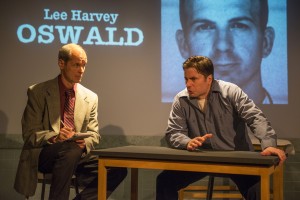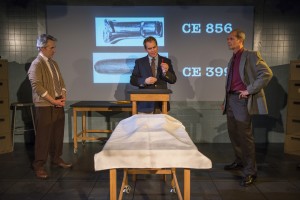Production examines Chicago ties to JFK murder
By Kevin Beese For Chronicle Media — September 3, 2015
Mark Ulrich (left) and Martin Yurek in the world premiere of “Assassination Theater: Chicago’s Role in the Crime of the Century.” Forest Park playwright Hillel Levin examines the cover-up surrounding President John F. Kennedy’s death and what role Chicago mafia figures may have played in the assassination. (Photo by Michael Brosilow)
Did Chicago mob figures play a role in the assassination of President John F. Kennedy?
That is one of the questions raised by Forest Park playwright Hillel Levin in an ongoing production at the Museum of Broadcast Communication.
In the world premiere of the theatrical investigation “Assassination Theater: Chicago’s Role in the Crime of the Century,” Levin, an investigative reporter and author, examines the cover-up surrounding the president’s death and what role Chicago mafia figures may have played in the assassination.
Levin did a story for Playboy magazine in 2007 on the “Family Secrets” trial, linked to the burglary of reputed mob boss Tony Accardo’s River Forest home in 1978 and nine mob-related killings that followed.
“In the course of writing that story, I met former FBI agent Zack Shelton,” Levin said. “After that story, he called me and said now I needed to do the real story on how the mob killed JFK.”
Chicago mobsters that Shelton and Levin contend were part of the assassination plot were Sam “Momo” Giancana, Accardo and hit men Charles Nicoletti and Johnny Roselli.
U.S. Attorney General Robert Kennedy had ramped up the targeting of organized crime during his brother’s administration, angering union bosses, such as Accardo, Giancana and Jimmy Hoffa, and leading to the mob’s murder of the president, Levin alleges.
Levin and Shelton say that Nicoletti and Roselli were both in Dallas when Kennedy was assassinated, as were a host of other mob figures, raising questions about why so many reputed members of organized crime were in the city on Nov. 22, 1963. Neither Nicoletti nor Roselli is believed to have fired the fatal shot, but both may have been involved in the assassination plan, Levin alleges.
The infamy of the fatal shot should go to James Files, a class X felon serving a 30-year sentence for attempted murder, according to Levin. Both Levin and Shelton contend that Files was located on the grassy knoll that day and fired the shot that hit Kennedy from the front and exited from the back of his head, which was believed to be the initial cause of death, according to doctors at Parkland Hospital in Dallas. The Warren Commission said the fatal shot came from behind and from the gun of Lee Harvey Oswald in the Texas Book Depository.
Levin said information from Shelton, who had interviewed Files extensively, got him investigating the assassination.
“From what (Shelton) told me and with how much has come out about the assassination, I have been looking for seven years on how to put the information into a play,” Levin said. “I thought that was the best way to get the story out.”

Performing a scene from “Assassination Theater: Chicago’s Role in the Crime of the Century,” are (from left) Michael Joseph (from left) Mitchell, Ryan Kitley and Mark Ulrich. (Photo by Michael Brosilow)
Levin said information has come out over the years that points to an assassination cover-up that most of the mainstream media has turn a blind eye to. He cited a 1998 Washington Post article that contends two different brains were used for examination in the days following the assassination and that the alleged photos of Kennedy’s brain in the National Archives are likely not his brain.
“I am 90 to 95 percent certain that the photographs in the archives are not of President Kennedy’s brain,” Douglas Horne, the Assassinations Records Review Board’s chief analyst for military records, said in the article.
“That is shocking information,” Levin said. “… I find it very shocking the media chooses not to look at what the government implied. The initial information all points to there being more than one shooter, but hours after the assassination, the government was trying to cover up any talk of another shooter.”
Levin said with the country having just gone through the Cuban Missile Crisis, allowing multiple-shooter theories to exist immediately after the Kennedy shooting could have touched off an international incident.
“They were all concerned this would touch off a nuclear war,” Levin said. “They did not want to reveal that this was somehow a Communist conspiracy. Oswald was painted with intention. This was incredibly volatile stuff. They did not want the public to have any idea. There was also the possibility that this could make us look weak.”
Levin’s theatrical investigation runs at the Museum of Broadcast Communication, 360 N, State St., Chicago, through Nov. 7. Where is goes after that is still up in the air.
“I want to take it one step at a time,” Levin said. “I want it to be a success. I hope people go out and see it.”
Levin said even when he wrote an article for Playboy in 2010 on how the Outfit played a role in JFK’s murder, “I still didn’t understand all the issues of the cover-up.”
“There is a wealth of information,” Levin said. “The question was what could I distill in two hours (for a play) that would be the most convincing to an audience.”
For information and tickets to Levin’s production, go to http://www.assassinationtheater.com.
— Production examines Chicago ties to JFK murder —



